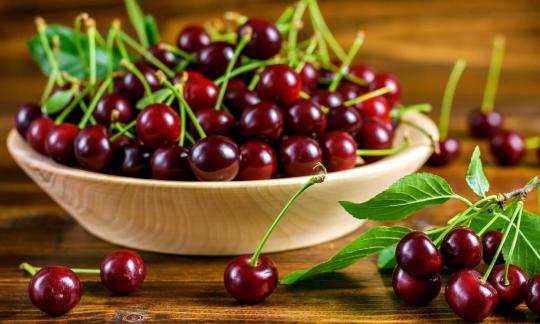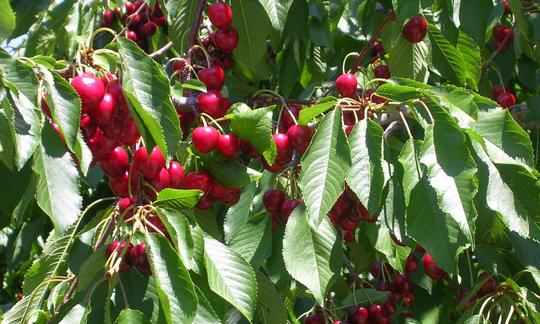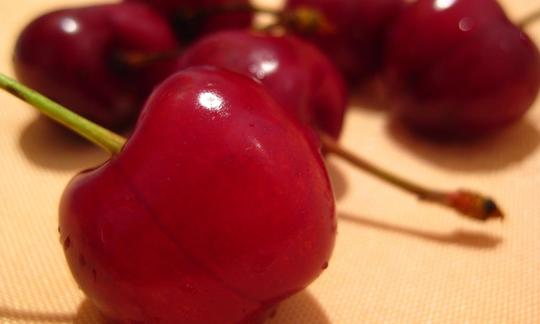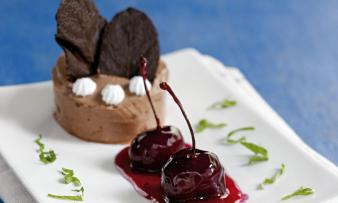Table of contents
The sour cherry ( Prunus cerasus ) is also known as the sour cherry . This edible stone fruit, also known in some places as the sour cherry, has a characteristically sour taste in contrast to the fruity sweetness of the cherry or sweet cherry .
Use in the kitchen
Sour cherries are characterized by their high fruit acid content and the resulting sour taste. The red fruit only tastes good when fresh and raw when it is fully ripe, but this also depends on the variety. Sour cherries become much more important when combined with sugar. Industrially processed sour cherries in particular are very popular as pickled cherries, compotes, jams (marmalades) or juices. The dairy industry also uses sour cherries to make yoghurt or quark desserts. 34
Fresh cherries are suitable for a variety of cakes, mousses, strudels, mueslis (e.g. pea muesli ), ice creams or smoothies. One of the most famous desserts is probably the Black Forest gateau with sour cherries.
Dried sour cherries can be found in ready-made muesli mixes or as dried fruit. The raw fruit and the juice are particularly beneficial to health.
Vegan recipe for sour cherry and nut cake
Ingredients: 170 g vegetable margarine, 140 g brown sugar, 1 banana, 100 g ground hazelnuts, 40 g chopped walnuts, 200 g pitted sour cherries (possibly from a jar), 150 g spelt flour, 1 teaspoon cream of tartar baking powder, 1 teaspoon cinnamon powder, 50 ml rice milk, 100 g chopped dark chocolate, margarine for the mold.
Preparation: Preheat the oven to 180 °C top/bottom heat. Mix the margarine and sugar in a bowl and mix with the mashed banana. Chop the walnuts and half of the chocolate and mix in with the ground hazelnuts. Mix the sifted flour with the baking powder and cinnamon and add. Finally, stir in the rice milk well. Pour the dough into a greased springform pan and spread the drained sour cherries evenly on top. Then put it in the oven and bake for approx. 45-50 minutes. After it has cooled, melt the remaining chocolate in a water bath and spread it over the cake. Alternatively, you can just sprinkle it with powdered sugar .
Recipe for sour cherry and vanilla jam
Ingredients: 1 kg sour cherries, 1 kg gelling sugar, 1 vanilla pod .
Preparation: Wash and pit the cherries. After draining, place in a large saucepan and mix well with gelling sugar. Cut open the vanilla pod, scrape out the pulp and add it, including the pod, to the cherry-sugar mixture. Bring the fruit to the boil while stirring constantly and let it simmer for a few minutes. Stir constantly. Remove the vanilla pod and pour the hot jam into clean screw-top or Weck jars. Alternatively, you can finely puree the sour cherry jam with a hand blender and then bottle it. Turn the tightly sealed screw-top jars (not the Weck jars) upside down for 5 minutes. Then wipe the rims well, label them and store in a dark, cool place.
Vegan recipes with sour cherries can be found under the note: " Recipes that have the most of this ingredient ".
| Not only vegans or vegetarians should read this: Vegans often eat unhealthily. Avoidable nutritional mistakes . |
Purchasing - Storage
Sour cherries are rarely available fresh from major retailers such as Coop, Migros, Denner, Volg, Spar, Aldi, Lidl, Rewe, Edeka, Billa, Hofer etc. They are usually found pitted as compote in glass jars, rarely in cans, with water and mostly sugared. Organic sour cherries in jars are available from organic supermarket chains such as Alnatura and Denn's Biomarkt . These are also available unsweetened.
Fresh sour cherries are available from June to mid-August at weekly markets, in selected supermarkets (mostly with a regional focus) and in some places also from small roadside stands.
The availability of sour cherries varies depending on the size of the store, catchment area, etc. Our recorded food prices for the DA-CH countries can be found above under the ingredient image - and by clicking on them you can see their development at various suppliers.
Wildly found:
Sour cherry trees often grow wild in hedges, vineyards or in open oak forests, but no truly wild forms are known. 1
Storage tips
How long do sour cherries last? Fresh sour cherries are very sensitive and should be consumed quickly to avoid any loss of quality. 34 The sour cherries should only be washed and pitted shortly before use, otherwise they will lose their aroma. Cherries do not ripen, so it is best to only pick them when they are fully ripe. Sour cherries will stay edible for around 10 days at 0-2 °C.
Can you freeze sour cherries? If you want to freeze the cherries, you should drain them after removing the stones, place them on a tray and freeze them. Only then should you put them in a freezer bag and freeze them completely. This way, the fruits can be removed individually and do not stick together.
Ingredients - Nutritional values - Calories
Sour cherries have around 50 kcal per 100 g. 12% of this is carbohydrates, of which around 8.5% is sugar and 1.6%is fiber . Proteins and fats are hardly present in this fruit, but the water content is over 86%. 2
Although this type of cherry tastes so sour, this has little to do with the ascorbic acid it contains. The vitamin C content is only 10 g/100g of cherries. Apricots and avocados have the same values. Strawberries are a good source of vitamin C as fresh fruit, with around 59 g/100g. Kiwis also provide a lot of the important antioxidant, with 93 mg. 2
Potassium is an essential element that is found in many foods. In terms of potassium content, sour cherries with 173 mg/100g are on a par with sage or green bell peppers . Dried herbs have a lot of potassium ( dried parsley : 2,683 mg/100g), but lamb's lettuce (459 mg/100g) and bananas (358 mg/100g) also have significant amounts. 2
The vitamin A content of sour cherries is identical to that of passion fruit at 64 µg/100g. The fat-soluble vitamin is usually present as provitamin A in the form of carotenoids in plant-based foods. Carrots, for example, have a very high vitamin A content of 835 µg per 100g of vegetables. Baby spinach is also a good source of this vitamin at 469 µg/100g. 2
You can find all the ingredients of sour cherries, how much they cover your daily needs and comparative values with other ingredients in our nutrient tables. In the article Nutrients comprehensively explained you will get a detailed insight into the topic.
Health effects
Why are cherries healthy? Plants with red, purple, blue or blue-black fruits contain anthocyanins. These water-soluble plant pigments have bioactive properties in addition to their coloring power. They have antioxidant and anti-inflammatory effects. 3 In addition to the anthocyanins, other flavonoids such as catechin, quercetin and kaempferol are also included, which also protect against free radicals, bacteria and viruses. They are also said to prevent heart disease and tumors. 4
The anthocyanins contained in the fruit are said to have a positive effect on bone density and thus prevent osteoporosis. These plant pigments are also said to have a preventive effect against stroke. Experiments with sour cherry extract and essential fatty acids as well as extracted sour cherry anthocyanins also show positive effects against Alzheimer's. 5,6
The antioxidant chlorogenic acid is said to inhibit the absorption of sugar in the blood and thus counteract diabetes and lower blood pressure. In addition to cancer, chlorogenic acid is also said to reduce the risk of cardiovascular disease. 7 It is not clear whether this ester of caffeic acid really helps against stomach or liver inflammation.
How healthy is sour cherry juice? Studies show that the juice of sour cherries (especially the Montmorency variety) can reduce muscle soreness and fatigue during excessive exercise. 8 In addition, the body can absorb the bioactive components better from the juice than from the plant tissue. 9
Sour cherries are said to help with sleep disorders because they increase melatonin levels. 10 The natural hormone melatonin plays a role in controlling the sleep-wake cycle. 26 The natural melatonin contained in sour cherries with up to 13.5 mg/g is therefore said to counteract a deficiency. The melatonin content can vary greatly depending on the variety. 11 Eating small amounts of cherries every day can increase the melatonin level in the blood. 11, 12
In addition to their alkaline effect, the fruit acids contained in sour cherries also have a potentially positive influence on the intestinal microbiome and accelerate the metabolism. 13
Secondary plant substances
Many of the health effects of sour cherries can be attributed to the secondary plant substances they contain. Our article on secondary plant substances provides an overview of the classification of substance groups, their occurrence in foods and possible effects on humans. Cherries ( sweet and sour) contain the following secondary plant substances: 20
- Polyphenols : flavonoids (flavonols, flavones, anthocyanins), phenolic acids (hydroxycinnamic acids, hydroxybenzoic acids)
However, it should be noted that the composition of secondary plant substances in sour cherries can vary depending on temperature, light, fertilization and degree of ripeness. 20 Therefore, quantities are only of limited use and should only be understood roughly.
Dangers - Intolerances - Side effects
Neither sweet nor sour cherries are recommended for people with fructose intolerance. Although sour cherries taste significantly less sweet, 100 g still contain around 4 g of fructose. Sweet cherries contain 5 to 6 g/100g. 2,27 Depending on sensitivity, an amount of more than 3 g of total fructose can cause symptoms such as a feeling of fullness and flatulence, as well as cramp-like pain and diarrhea. 27, 28
If you have gastrointestinal problems, the high fruit acid content of sour cherries can cause discomfort. In this case, you should prefer fruit that is low in volatile acid, such as bananas, mangos or pears .
Use as a recognized medicinal plant
The bark, leaves, flowers, seeds and resin of cherry trees were once used for medicinal purposes. The bark and leaves contain not only tannins, but also hydrocyanic acid glycosides (hydrocyanic acid glycosides). The cherry seeds contain a much higher content of poisonous amygdalin. 14
The fruits are astringent, blood-forming and diuretic. The cherry stems are also said to be good for stubborn coughs and have a diuretic effect. 14
Folk medicine - natural healing
In traditional medicine, an infusion made from the root bark was drunk to treat ulcers and wounds as well as fever and coughs. The sour cherry was also consumed as a remedy for sleeping problems. 31
Regular consumption of all kinds of cherries is said to ward off chronic diseases such as arthritis, gout, rheumatism, arteriosclerosis, constipation, stomach problems, liver diseases, etc. 15 The substances contained in the cherry stone also stimulate breathing and improve digestion. 31
Ecological footprint - animal welfare
The ecological footprint of a food depends on various factors. The type of agricultural production (conventional vs. organic), seasonal, regional or domestic production or import by truck, ship or plane, different types of packaging and whether the goods are fresh or frozen all play a decisive role. 22
In Poland, cherries ( sweet and sour) have a carbon footprint of 0.65 kg CO 2 eq/kg (mainly production) according to CarbonCloud . The use of agricultural machinery for activities such as fertilizer application and harvesting contributes to 64% of emissions. This is followed by emissions from field bacteria and fertilizer production. 21
By comparison, vegetables, one of the most climate-friendly foods, have a carbon footprint of around 0.1-0.5 kg CO 2 eq/kg depending on the cultivation method (and excluding the impact of transport). 2 3 The average carbon footprint of plant-based foods is around 0.66 kg CO 2 eq/kg, which is only 10.7% of the CO 2 emissions of animal products (6.15 kg CO 2 eq/kg). 24 To keep the carbon footprint small, it is best to eliminate animal products from your diet.
The water footprint of sour cherries is 1411 l/kg. Barley and rye have a comparable water footprint, with the largest part being so-called 'green water'. The green water footprint indicates the amount of rainwater used in production. 22
For detailed explanations of various sustainability indicators (such as ecological footprint, CO2 footprint, water footprint), see our article: What does the ecological footprint mean?
Animal protection - species protection
When in bloom, cherries, especially local varieties, are an ideal food source for bees and wild bees. 23 Although sour cherries are self-fertile, pollination by honey bees increases the yield by two or four times. 24 Most cherry varieties also need bees for pollination. 25 For example, wet and cold weather during cherry blossom season can lead to crop failures, as insects do not fly in wet weather. 24
Worldwide occurrence - cultivation
Sour cherries come from the Middle East, but grow in almost the entire northern hemisphere. In Finland they can be found up to the 63rd parallel and in Norway up to the 68th parallel. In some cases sour cherries grow up to 1800 m above sea level. 1
According to the FAO, the harvest figures for sour cherries are around 1.6 million tons (2022). 16 Due to the difficult conditions, the share of sour cherry areas in Germany in 2023 was not very large at just under 2000 hectares. Germany is the third largest importer of cherries worldwide. 35 Variety trials and biological pest control trials are intended to help increase the market share of organic goods. 17
Growing in the garden
The ideal variety for growing in your own garden depends very much on personal preferences and the garden conditions. There are numerous early, medium and late ripening varieties of sour cherries. When choosing a variety, you should also pay attention to the trees' susceptibility to disease. Some varieties are very intensely sour, but there are also sour cherries that contain less acid due to breeding. Depending on the size of the garden, you should not ignore the height of the plant and, for smaller areas, choose dwarf varieties or shrubs.
Sour cherries are usually self-pollinating, so only one tree is needed. The trees are also naturally smaller and are better suited to small gardens than sweet cherries . 29,34 Sour cherries can tolerate lower temperatures, but still need plenty of sun and warmth to ripen. Plant the tree in the fall in rich, moist soil that is not too wet. 29,34 In colder climates, plant the tree on a trellis against the wall of the house to provide better warmth and protection. 29 The fruit can be easily removed from the stem by hand. 34
Industrial production
As a shrub or tree, the sour cherry reaches heights of up to 10 meters. It grows on loose, light, nutrient- and base-rich, sandy loam soils. The edible stone fruits measure around 15-20 mm, are more or less spherical, only slightly higher than they are wide; the flesh is red or uncolored. 1 For commercial harvesting, machines are used that shake the tree and catch any cherries that fall. 34 The most common varieties available in stores are the Morello cherry, the Amarelle cherry and the Montmorency cherry. 31 The flowering period is from April to May and the harvest time is from June to July or August at the latest. 14, 34
Sour cherries suffer from fewer pests and diseases than sweet cherries . The main threats come from birds and damage caused by aphids and caterpillars.31,34 However, sour cherries are much more susceptible to monilia (fungus) .34 The larvae of the cherry fruit fly ( Rhagoletis cerasi ) mainly attack sweet cherries ( Prunus avium ), but sour cherries ( Prunus cerasus ), honeysuckle ( Lonicera ), snowberries ( Symphoricarpos ) and black cherry ( Prunus padus ) are also food sources.33 In conventional fruit growing, the use of insecticides is therefore seen as indispensable, even though Greenpeace classified pesticides as harmful to health in 2015. 32 In organic farming, on the other hand, attempts are made to keep the larvae under control using close-meshed nets, sticky traps, insect-damaging nematodes and fungi. 17,33
Further information
The sour cherry ( Prunus cerasus ) belongs to the rose family (Rosaceae) and the tribe of stone fruit plants (Amygdaleae). The genus Prunus also includes well-known species such as apricot ( Prunus armeniaca ), plum ( Prunus domestica ) and almond ( Prunus dulcis ).
Sour cherries have thin branches and usually overhanging twigs. Sweet cherries have a much stronger growth and grow taller. The crown of sour cherries is usually round to overhanging, while sweet cherries grow pyramidal to broadly fanned. 18 The flowers of the two trees are very similar and have a similar flowering period. 29,34
When the trees bear fruit, they can be clearly distinguished. The sour cherries are smaller, softer, more sour, more glassy and are harvested much later. 29,34
Sour cherries and sweet cherries can be self-sterile, but they can also self-pollinate or cross-pollinate, depending on the variety. 19, 29
The subspecies are the tree sour cherry and the shrub sour cherry. The sour cherry tree ( Prunus cerasus subsp. cerasus ) is divided into two varieties: 1
- The glass cherry, water cherry or amarelle ( Prunus cerasus var. cerasus ) with light red, glassy and sour fruits, the stone is difficult to separate from the stem.
- The sweet cherry, Morello ( Prunus cerasus var. austera L.) has red, sweet and sour fruits with colored juice. The stone easily separates from the stem.
The sour cherry, also known as Morello cherry ( Prunus cerasus subsp. acida ), grows as a shrub or small tree. The dark red, sour fruits have a colored juice. This species forms root runners. 1 Morello cherries are very popular cherries because they are considered to be very undemanding plants and produce many blackish-red cherries even when grown in the shade. 1,31
Alternative names:
Sour cherries are called sour cherries in English (singular: sour cherry), in the literature they are also referred to as tart cherries.
Other uses
Cherry stone oil is known in medicine for the relief of spleen and urinary disorders. Dried cherry stones can store heat well and release it slowly, which is why cherry stone pillows are used for tension and joint pain. 30 This oil is also used in cosmetic products. 31
A green dye can be obtained from the leaves and a dark grey to green dye from the fruit. The trunk of the sour cherry also produces a kind of gum that serves as an adhesive. 31
Bibliography - 35 Sources (Link to the evidence)
| 1. | Scholz H, Scholz I. Prunus. In: HJ Conert (Hrsg.): G Hegi. Illustrierte Flora von Mitteleuropa. Spermatophyta: Angiospermae: Dicotyledones. Rosaceae. Blackwell 1995:4(2B). |
| 2. | USDA United States Department of Agriculture. |
| 3. | Schuster M, Hoberg E, Schütze W. Die Vielfalt der Anthocyane in Sauerkirsche, Prunus cerasus L., im Vergleich mit anderen Kirscharten, Prunus ssp. Julius Kühn-Institut. Bundesforschungsinstitut für Kulturpflanzen. 2008. |
| 4. | Rodriguez-Garcia C, Sanchez-Quesada C, Gaforio JJ. Dietary Flavonoids as Cancer Chemopreventive Agents: An Updated Review of Human Studies. Antioxidants. 2019;8(5):137. |
| 5. | Matchynski JJ, Lowrance SA, Pappas C et al. Combinatorial treatment of tart cherry extract and essential fatty acids reduces cognitive impairments and inflammation in the mu-p75 saporin-induced mouse model of Alzheimer's disease. Journal of Medicinal Food. 2013;16(4). |
| 6. | Jiangyong M, Seong-Woon Y, Seung-Hoon B et al. Neuroprotective effect of cyanidin-3-O-glucoside anthocyanin in mice with focal cerebral ischemia. Neuroscience Letters. 2011;500(3):157-161. |
| 7. | Naveed M, Hejazi V, Abbas M et al. Chlorogenic acid (CGA): A pharmacological review and call for further research. Biomed Pharmacother. 2018;97. |
| 8. | Bowtell J, Summers DP, Dyer A et al. Montmorency cherry juice reduces muscle damage caused by intensive strength exercise. Medicine & Science in Sports & Exercise. 2011;43(8). |
| 9. | Netzel M, Strass G, Kaul C et al. In vivo antioxidative capacity of a composite berry juice. Food Res Int. 2002;35(2-3):213-216. |
| 10. | Howatson G, Bell P, Tallent J et a. Effect of tart cherry juice (Prunus cerasus) on melatonin levels and enhanced sleep quality. European Journal of Nutrition. 2012;51:909-916. |
| 11. | Burkhardt S, Tan DX et al. Detection and quantification of the antioxidant melatonin in Montmorency and Balaton tart cherries (Prunus cerasus). Journal of Agricultural and Food Chemistry. 2001;49(10). |
| 12. | Brown G. Researcher says tart cherries rich in melatonin. The Fruit Growers News. 2001. |
| 13. | Alba C. MA, Daya M, Franck C. Tart Cherries and health: Current knowledge and need for a better understanding of the fate of phytochemicals in the human gastrointestinal tract. Critical Reviews in Food Science and Nutrition. 2019;59(4):626–638. |
| 14. | Fleischhauer SG, Guthmann J, Spiegelberger R. Enzyklopädie - Essbare Wildpflanzen. AT Verlag: Aarau. 2013. 4. Auflage. 2018. |
| 15. | Roger JDP. Heilkräfte der Nahrung. Ein Praxishandbuch. Advent-Verlag: Zürich. 2006. |
| 16. | FAOSTAT Food and Agriculture Organization of the United Nations. Crops and livestock products. 2023. |
| 17. | Pini U. Das Bio-Food Handbuch. Ullmann: Hamburg, Potsdam. 2014. |
| 18. | Gartenjournal. Sauerkirsche und Süsskirsche - welche Unterschiede gibt es? |
| 19. | Rehm S, Espig G. Die Kulturpflanzen der Tropen und Subtropen. Anbau, wirtschaftliche Bedeutung, Verwertung. Eugen Ulmer: Stuttgart. 1976. |
| 20. | Ferretti G, Bacchetti T et al. Cherry antioxidants: from farm to table. Molecules. 2010;15(10):6993–7005. |
| 21. | Carboncloud. Cherries, Poland. 2014. |
| 22. | Mekonnen MM, Hoekstra AY. The green, blue and grey water footprint of crops and derived crop products. Hydrol Earth Syst Sci. 2011;15(5):1577–1600. |
| 23. | Horn H, Lüllmann C. Das grosse Honigbuch. Kosmos: Stuttgart. 3. Aufl. 2006. |
| 24. | Seeds. University of Guelph. Sour Cherries (Prunus avium). |
| 25. | Benedek P, Nyéki J et al. Both self-sterile and self-fertile sour cherries need insect (Bee) pollination. Acta Hortic. 2005;(667):399–402. |
| 26. | Cleveland Clinic. Melatonin. 2022. |
| 27. | foodintolerances.org Fructose. |
| 28. | Fedewa A, Rao SSC. Dietary fructose intolerance, fructan intolerance and FODMAPs. Curr Gastroenterol Rep. 2014;16(1):370. |
| 29. | The Tree Center. Sweet or Sour? What are the different kinds of cherries? 2024. |
| 30. | Lagoni N. Vogelkirschen – Grundlage für Heilmittel und Obstbrände. LWF Bayerische Landesanstalt für Wald und Forstwirtschaft. Wissen 65. 2010. |
| 31. | Woodland Trust. Cherry Sour (Prunus cerasus). |
| 32. | Greenpeace. Europe's Pesticide Addiction: How Industrial Agriculture Damages our Environment. 2015. |
| 33. | Daniel C, Grunder J. Integrated management of European Cherry Fruit Fly rhagoletis cerasi (L.): Situation in Switzerland and Europe. Insects. 2012 Oct 16;3(4):956–988. |
| 34. | Mein schöner Garten. Sauerkirschen. 2018. |
| 35. | USDA FAS. Overview on the German Cherry Sector - 2023. 2023. |













Comments